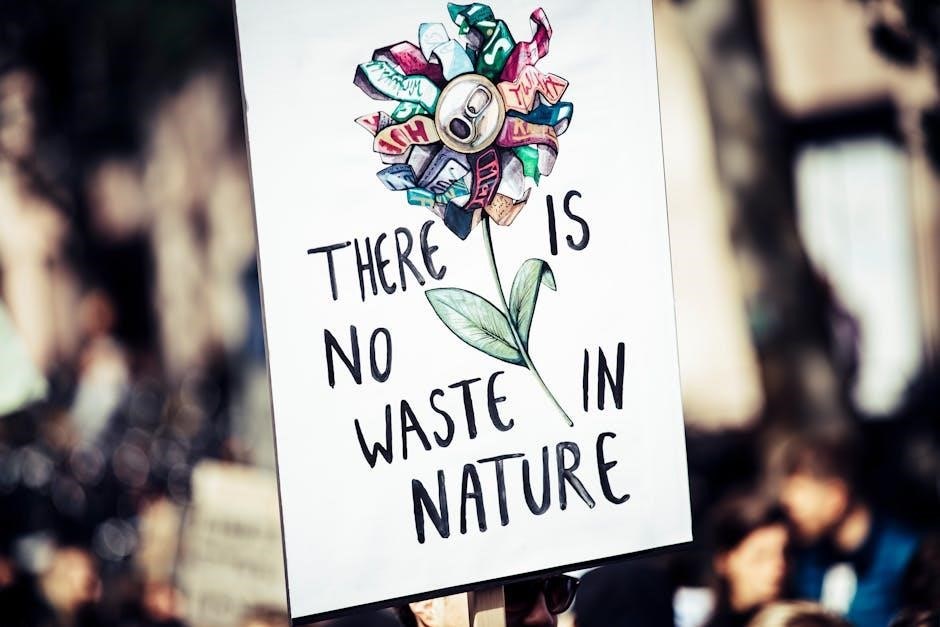The art of letting go is a transformative practice that fosters inner peace and mental clarity. By releasing emotional burdens‚ you reclaim control over your thoughts and happiness‚ embracing a life of freedom and balance.
1.1. What is Letting Go?
Letting go is the mindset and process of releasing negative emotions‚ thoughts‚ and patterns. It involves embracing emotional freedom‚ finding peace‚ and moving beyond struggles. Through mindfulness and self-reflection‚ it allows individuals to detach from burdens‚ fostering a clearer and more balanced life‚ leading to personal transformation and harmony in daily existence.
1.2. Importance of Letting Go
Mastering the art of letting go is vital for emotional well-being and personal freedom. It liberates individuals from mental clutter and negativity‚ allowing them to regain control over their thoughts and emotions. By letting go‚ one can achieve inner peace‚ foster resilience‚ and unlock their true potential‚ leading to a more fulfilling and balanced life.
1.3. Purpose of the Article
This article aims to guide individuals in understanding and practicing the art of letting go. It offers practical strategies‚ mindfulness techniques‚ and psychological insights to help release emotional burdens and cultivate inner peace. By exploring various methods‚ readers can transform their lives‚ embracing freedom from negativity and fostering personal growth‚ ultimately leading to a more authentic and fulfilling existence.

Understanding the Concept of Letting Go
Letting go is the process of releasing emotional burdens and negative thoughts‚ allowing individuals to embrace inner peace and freedom‚ fostering personal growth and a balanced life.
2.1. Letting Go as a Mindset
Adopting a mindset of letting go involves embracing detachment from negative emotions and thoughts. It’s about recognizing that true freedom lies in releasing what no longer serves you. By shifting focus from attachment to acceptance‚ individuals can cultivate inner peace and clarity. This mindset isn’t about indifference but rather about consciously choosing to release burdens‚ allowing for personal growth and emotional liberation. It’s a powerful tool for transforming one’s life.
2.2. The Science Behind Emotional Release
Emotional release is rooted in neuroscience‚ where holding onto negativity activates the brain’s stress response. Letting go deactivates this response‚ reducing cortisol levels. Techniques like mindfulness and cognitive restructuring help rewire the brain‚ fostering emotional detachment. This process promotes mental clarity and resilience. Understanding this science empowers individuals to approach letting go as a deliberate‚ impactful practice for emotional well-being and peace.

Psychological Strategies for Letting Go
Psychological strategies for letting go involve techniques like externalization and narrative therapy‚ which help individuals effectively release negative emotions and patterns‚ fostering emotional freedom and mental clarity.
3.1. Externalization and Narrative Therapy
Externalization and narrative therapy are powerful tools for letting go. These approaches help individuals separate themselves from negative emotions‚ viewing them as external challenges rather than personal identities. By rewriting personal narratives‚ people can reclaim their stories‚ fostering empowerment and detachment from past hurts. This process encourages emotional freedom and a healthier perspective on life’s difficulties.
3.2. Cognitive Restructuring Techniques
Cognitive restructuring is a powerful method to challenge and change negative thought patterns. By identifying and reframing unhelpful beliefs‚ individuals can release emotional burdens. This technique encourages a shift in perspective‚ fostering mental clarity and emotional freedom. Regular practice helps break free from mental clutter‚ allowing for a more balanced and peaceful mindset. It’s a key step in mastering the art of letting go‚ promoting lasting inner harmony and personal growth.
Moving Beyond Hurt and Pain
Moving beyond hurt involves releasing emotional burdens and embracing healing. Mindfulness and self-reflection help transform pain into growth‚ fostering freedom and inner peace. Letting go liberates the soul.
4.1. Breaking Free from Toxic Relationships
Toxic relationships drain your energy and hinder personal growth. Recognizing harmful patterns is the first step towards liberation. Setting boundaries and prioritizing self-care can help you distance yourself emotionally and physically. Forgiveness is not for others‚ but for your own healing. Letting go of such relationships creates space for healthier connections and a more fulfilling life. Embrace freedom from toxicity to restore your peace and well-being.
4.2. The Role of Forgiveness
Forgiveness is a powerful step in the art of letting go‚ allowing you to release emotional burdens and heal. It doesn’t mean reconciling with others but freeing yourself from resentment. By forgiving‚ you reclaim peace and move forward. Self-forgiveness is equally important‚ letting go of guilt and embracing self-compassion. Forgiveness transforms pain into wisdom‚ fostering personal growth and inner harmony. It’s a journey‚ not a destination‚ that liberates your heart and mind.

Mindfulness Practices to Facilitate Letting Go
Mindfulness practices‚ such as meditation and journaling‚ help cultivate emotional detachment and inner peace. By focusing on the present‚ you release negative emotions and embrace freedom.
5.1. Meditation for Emotional Detachment
Meditation is a powerful tool for achieving emotional detachment. By observing thoughts without attachment‚ you cultivate mental clarity and inner peace. Sitting with discomfort helps release burdens‚ fostering freedom and calm. Regular practice enhances self-awareness‚ allowing you to let go of negativity and embrace life’s flow. This practice is essential for mastering the art of letting go‚ as it transforms your relationship with emotions and thoughts‚ leading to a more balanced and serene life.
5.2. The Power of Journaling
Journaling is a potent tool for emotional release and self-reflection. By externalizing thoughts and feelings‚ you gain clarity and perspective‚ allowing you to process emotions more effectively. This practice helps identify patterns of attachment and reframe negative narratives. Regular journaling fosters mindfulness‚ enabling you to let go of burdens and embrace a lighter‚ more liberated life. It’s a therapeutic outlet that empowers personal growth and emotional freedom.

Embracing a Non-Attachment Mentality
Embracing a non-attachment mentality is a powerful step toward inner peace. It allows you to release emotional burdens‚ fostering freedom and clarity in your life’s journey.
6.1. Understanding Non-Attachment
Non-attachment is a mindset where you release emotional dependence on outcomes or possessions. It doesn’t mean detachment but rather a balanced approach to life‚ allowing you to embrace experiences without being controlled by them. This practice fosters freedom‚ reducing suffering caused by clinging to what’s beyond your control. By letting go‚ you cultivate inner peace and clarity‚ enabling a more authentic and fulfilling life. It’s about surrendering the need to hold on tightly‚ trusting in the natural flow of life. This concept‚ rooted in mindfulness and self-awareness‚ helps you navigate life’s challenges with resilience and grace‚ leading to emotional liberation and personal growth. Understanding non-attachment is the first step toward embracing a life of freedom and harmony.
6.2. Benefits of a Detached Life
A detached life offers profound emotional freedom and inner peace. By letting go of unnecessary attachments‚ you reduce anxiety and stress‚ fostering resilience. Detachment allows you to observe life’s challenges without being overwhelmed‚ promoting mindfulness and clarity. It encourages authenticity‚ helping you align with your true self and values. This mindset cultivates gratitude‚ enabling you to appreciate what truly matters. Embracing detachment leads to a life of balance‚ harmony‚ and purpose.

Breaking Free from Toxic Relationships
A detached life fosters emotional freedom‚ reducing anxiety and stress. It promotes resilience‚ allowing you to observe challenges without being overwhelmed. Detachment encourages mindfulness‚ clarity‚ and authenticity‚ helping you align with your true values. This mindset cultivates gratitude‚ enabling appreciation for what truly matters. Embracing detachment leads to a balanced‚ harmonious‚ and purposeful life‚ free from unnecessary burdens.
7.1. Identifying Toxic Patterns
Recognizing toxic patterns in relationships involves acknowledging signs like manipulation‚ emotional abuse‚ or control. These behaviors often leave you feeling drained or invalidated. Identifying such dynamics is the first step toward liberation. Pay attention to consistent disrespect‚ gaslighting‚ or a lack of accountability. These red flags indicate unhealthy connections that hinder personal growth. Awareness empowers you to take action‚ fostering the courage to distance yourself and reclaim your emotional well-being.
7.2. Strategies to Distance Yourself
Setting boundaries is essential to create emotional and physical space from toxic relationships. Limiting contact and avoiding triggers can prevent further harm. Focus on self-care by engaging in activities that uplift your spirit. Surround yourself with supportive individuals who encourage growth. Mindfulness practices‚ like meditation‚ can help maintain emotional balance. Gradually reducing emotional investment allows you to detach gracefully‚ fostering a healthier mindset and empowering you to move forward.

The Forgiveness Process
Forgiveness liberates you from negativity‚ allowing emotional healing and peace. It transforms pain into growth‚ fostering self-liberation and paving the way for a freer‚ more joyful life;
8.1. Forgiving Others and Yourself
Forgiveness is a powerful process that involves releasing negativity and anger toward others and yourself. It allows emotional healing and peace‚ transforming pain into growth. Self-compassion and empathy are key‚ as they help acknowledge past hurts without judgment. Forgiving yourself fosters self-liberation‚ while forgiving others breaks toxic cycles. This dual release creates a pathway to freedom‚ enabling personal renewal and a lighter‚ more joyful existence. It is an act of courage and grace.
8.2. Moving Forward After Forgiveness
Moving forward after forgiveness involves embracing a renewed sense of purpose and clarity. It requires setting boundaries and focusing on personal growth. Forgiveness clears the path for healing‚ allowing you to release emotional burdens and redirect energy toward positivity. By letting go of resentment‚ you create space for self-care‚ gratitude‚ and meaningful relationships. This transition empowers you to live authentically‚ fostering a mindset of resilience and joy‚ and guiding you toward a fulfilling future.

Letting Go of Resentment
Letting go of resentment liberates you from negative emotions and anger‚ allowing emotional freedom and inner peace. It’s a crucial step toward healing and personal growth.
9.1. Recognizing Resentment
Recognizing resentment involves acknowledging buried anger and unresolved conflicts. It often manifests as persistent bitterness or frustration‚ affecting mental health and relationships. By identifying these feelings‚ you can begin to address and release them‚ fostering emotional freedom and inner peace. Understanding the root causes is essential for genuine transformation and healing.
9.2. Techniques to Release It
Techniques to release resentment include mindfulness meditation‚ journaling‚ and cognitive restructuring. These practices help identify and challenge negative thought patterns‚ fostering emotional detachment. Forgiveness‚ whether of oneself or others‚ is also a powerful tool. By letting go of grudges and reframing perspectives‚ individuals can break free from resentment’s hold‚ embracing peace and personal growth. Regular practice of these methods cultivates a healthier mindset and promotes lasting emotional freedom.

Personal Growth Through Letting Go
Letting go fosters personal growth by releasing emotional burdens‚ fostering mental clarity‚ and embracing freedom. It allows individuals to transform their lives positively‚ leading to lasting peace and self-awareness.
10.1. How Letting Go Affects Growth
Letting go liberates individuals from emotional weights‚ allowing them to embrace personal growth. By releasing negative patterns and attachments‚ one gains mental clarity and space for positive transformation. This process fosters self-awareness‚ resilience‚ and a deeper understanding of oneself‚ enabling individuals to move forward with purpose and confidence. It creates a foundation for lasting change and inner peace‚ essential for holistic development.
10.2. Building a Positive Mindset
Building a positive mindset is a cornerstone of personal growth. Letting go allows individuals to shed negativity‚ fostering mental clarity and emotional resilience. By embracing non-attachment and self-awareness‚ one cultivates gratitude and optimism‚ which are essential for a fulfilling life. This shift in perspective empowers individuals to focus on possibilities rather than limitations‚ creating a strong foundation for lasting well-being and happiness.
Maintaining Inner Peace
Maintaining inner peace involves cultivating mental clarity and emotional balance through mindfulness and self-care‚ allowing individuals to navigate life’s challenges with grace and resilience.
11.1. The Role of Self-Care
Self-care is a cornerstone of maintaining inner peace. Through practices like meditation‚ journaling‚ and mindfulness‚ individuals restore balance and mental clarity. By prioritizing self-care‚ one fosters resilience‚ enabling the release of negative emotions and fostering emotional well-being. This holistic approach ensures a steady foundation for navigating life’s challenges with grace and poise‚ aligning with the principles of letting go and embracing a peaceful‚ detached mindset.
11.2. Sustaining Peace in Daily Life
Sustaining peace requires intentional daily practices. Mindfulness‚ meditation‚ and journaling help maintain emotional balance. By letting go of negative thoughts and embracing gratitude‚ individuals cultivate a serene mindset. Consistent self-care rituals‚ such as mindfulness exercises‚ foster resilience against stress. Over time‚ these habits create a stable foundation for inner harmony‚ allowing peace to permeate every aspect of life and promote long-term well-being.

Real-Life Applications of Letting Go
Letting go applies to overcoming loss‚ healing from trauma‚ and thriving in professional environments. It empowers personal growth and fosters resilience in daily life and relationships.
12.1. Overcoming Loss and Trauma
Letting go is a powerful process for healing from loss and trauma. By releasing emotional pain and embracing mindfulness‚ individuals can find liberation and peace. This practice allows them to move forward‚ rebuild their lives‚ and discover new meaning‚ fostering resilience and personal growth in the face of adversity.
12.2. Letting Go in Professional Settings
Letting go in professional environments fosters productivity and clarity. Releasing attachment to specific outcomes reduces stress and enhances decision-making. Embracing change and detachment from ego or perfectionism promotes collaboration and innovation. By letting go of control‚ professionals can delegate effectively‚ trust their teams‚ and focus on growth‚ leading to a more balanced and successful career.
Mastering the art of letting go leads to profound peace and freedom. It’s a journey of self-discovery‚ releasing burdens‚ and embracing life’s true potential with clarity and grace.
13.1. Recap of Key Points
The art of letting go emphasizes releasing emotional burdens‚ fostering mindfulness‚ and embracing non-attachment. It highlights strategies like cognitive restructuring‚ forgiveness‚ and journaling to achieve inner peace. By mastering these practices‚ individuals can transform their lives‚ gaining freedom from negativity and cultivating a positive mindset for personal growth and sustainable happiness.
